


|

|
 |
|
Nuclear power to the stars KEITH COOPER ASTRONOMY NOW Posted: 01 October 2011 To send spacecraft to other stars in the space of a human lifetime, new methods of propulsion are going to be needed to provide the necessary ‘oomph’ to break free of our Solar System. Currently the best bet is nuclear fusion power, but there’s a problem – it hasn’t even been shown to be a commercially viable source of energy on Earth yet. ‘Splitting the atom’ in the 1930s paved the way for modern day nuclear fission reactors, but nuclear fusion is a different and altogether far cleaner process. Rather than releasing binding energy of atoms energy by splitting them apart into lighter nuclei, fusion melds atomic nuclei together, but to so it is necessary to break though the electrostatic force, a fundamental repulsive force between two charged particles. To breach the electrostatic barrier high temperatures and pressures are required. The Sun’s core has a temperature of over 15 million degrees Celsius to generate energy by fusing hydrogen nuclei into helium. Nuclear fusion reactors on Earth basically have to match these conditions and, suffice to say, that isn’t easy. This is the challenge being faced not only by nuclear scientists worldwide, but also by those researchers of advanced spacecraft propulsion attending the 100 Year Starship Symposium in Orlando, Florida, this weekend.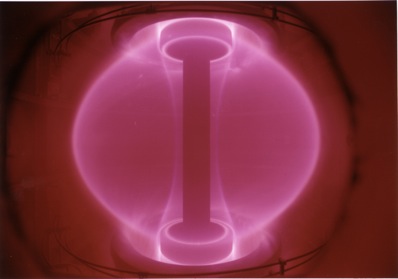 A plasma contained inside a tokamak. Image: CCFE. There are some ingenious solutions, however. In the picturesque Oxfordshire countryside, nestling on the bank of the River Thames, one would least expect a revolution in energy production to be taking place. Yet, here at the Culham Centre for Fusion Energy, nuclear scientists are attempting to create the future by operating the largest fusion reactor in Europe, the Joint European Torus (JET). Here they use a giant doughnut-shaped apparatus known as a tokamak – jargon for to(roidal) ka (chamber) mak (machine) – where powerful magnetic fields of at least one tesla (about 20,000 times Earth’s magnetic field) confine a plasma of deuterium and tritium nuclei through which an electric field is sent, heating the plasma to millions of degrees Celsius. This is termed a Magnetic Confinement Reactor (MRC), and the confinement is essential because were the plasma to touch the walls of the tokamak, not only would the plasma cool (‘quenching’ the reaction) it would also damage the reactor. The problem at the moment for nuclear fusion research is developing methods that produce more energy than is put into the system. The best the tokamak at JET has achieved is 16 megawatts of fusion power for two seconds, with an input of 25 megawatts (JET consumes so much electricity that permission has to be sought from the National Grid before switching it on). This energy deficit has to be reversed for fusion power to become viable, but there is new hope for the future: a 15 billion euro plan to build ITER, the International Thermonuclear Experimental Reactor near Marseille in France. 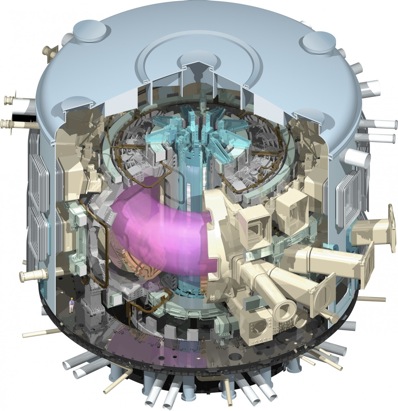 A cutaway of the ITER tokamak. Image: ITER. “The next big step is ITER,” says Dr Tim Hender, the Fusion Programme Manager at Culham. “It will be the first industrial scale tokamak experiment, with a 500 megawatt power output, and a net energy gain of ten.” If all goes well, ITER will show that commercially viable fusion reactors are possible. “We can expect to see fusion power from magnetic confinement on the National Grid by the middle of this century,” says Hender. “Because the fuels used in fusion are so plentiful – they are found in seawater and the Earth’s crust – once fusion is established it will give us a carbon-free energy source for many thousands of years.” Great, you might think. For starship enthusiasts, however, there’s a problem. A 7,000 tonne problem, actually. That’s the estimate for the mass of an interstellar spacecraft using a tokamak-based propulsion system. Considering that the International Space Station is just 417 tonnes, this weighty problem looks insurmountable. There’s an alternative though, one that you can find in your own home. Laser power 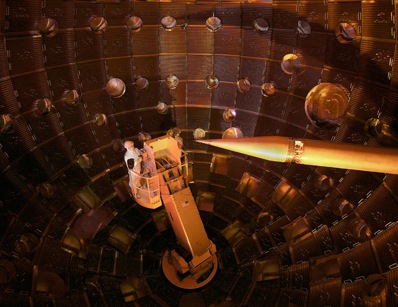 Technicians inside the target chamber at the National Ignition Facility. The pencil-like structure on the right holds the target. Image: Lawrence LIvermore National Laboratory. The advantage of laser driven fusion, also called Inertial Confinement Fusion (ICF), is that the reactor constitutes only has a small chamber and the laser system. It does not need the huge mass of a tokamak. Estimates suggest an ICF-based spacecraft for interstellar travel would have a mass less than 500 tonnes, including fuel. That’s still a tremendously large mass, but isn’t quite as insurmountable. In fact, ICF was recommended in the design of the British Interplanetary Society’s Daedalus project in 1977, and it is still in the hot seat for Daedalus’ follow-up, Project Icarus, says the University of Warwick’s Kelvin Long. Long is studying a PhD in ICF and laser plasma interactions, and is one of the leading lights behind Icarus, which is a joint five-year study between the British Interplanetary Society and the Tau Zero Foundation. Icarus is not an attempt to really build a starship, but rather a design study to show that interstellar travel could be possible, one day, and one of the obstacles that Icarus must overcome is the problem of mass. Long, however, is confident.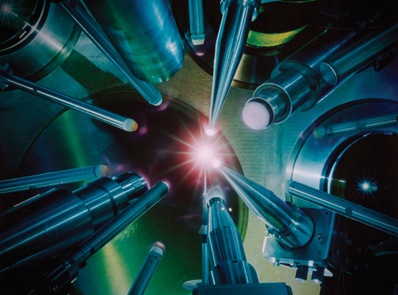 An inertial confinement laser known as OMEGA at the University of Rochester is used to test concepts for nuclear fusion. Image: Lawrence Livermore National Laboratory. “Look at the first computers that were the size of a huge room, and now I’m speaking to you on my Blackberry phone,” he says. “The history of technology shows that once something has been designed, we find better ways of doing it, we miniaturise the technology, and I’m personally confident that we can do the same with fusion within decades.” It may also be easier to miniaturise an ICF system than a tokamak. “To get the same power out of a smaller plasma will probably require active control of plasma instabilities, which is already partly being done, and ways to reduce the small scale turbulence in the plasma that causes heat to be lost,” says Hender. “Also, a more compact device will require structural materials that can withstand the higher loads from the high-energy fusion neutrons leaving the plasma. Even then an MCR fusion reactor including all the ancillary plant will be quite big.” To counter the mass problem, Daedalus had a two-stage engine design that improves the mass ratio. Just like the Saturn V rockets that took Apollo astronauts to the Moon had stages that dropped off, Daedalus’ first stage would exhaust its fuel before being jettisoned. This would lower the mass of the starship, so that the second stage would be fighting against less mass and be capable of reaching higher velocities. How fast can it go? The velocities achieved may sound quite disappointing for science fiction aficionados used to faster than light travel. Overall, thrusts of tens or hundreds of thousands of Newtons, with ‘specific impulses’ of millions of seconds, can be expected, leading to velocities of tens of thousands of kilometres per second. That’s fast, but the nearest star, Proxima Centauri, is around 40 trillion kilometres distant. It’s still going to take a long time to get there. "Specific impulse is a way of measuring performance," says Long. It is defined as the engine's thrust divided by the rate of propellant mass flowing through the engine (which results in units of seconds), and the higher the specific impulse, the greater the thrust generated by the engine using a specific amount of propellant. This means that the higher the specific impulse, the higher the exhaust velocity. "For interstellar journeys you need specific impulses of millions of seconds. Anything less than that is going to take over a century in terms of duration." By comparison, the maximum theoretical specific impulse that you can get from chemical engines is about 500 seconds, while ion engines have specific impulses of thousands of seconds. 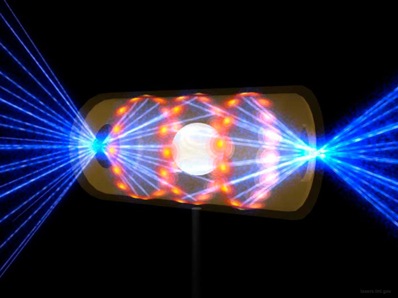 An artist’s impression of a laser beam heating and compressing a deuterium-tritium pellet to ignite nuclear fusion. Image: Lawrence LIvermore National Laboratory. Another factor in ICF propulsion systems is the rate at which pellets are fed into the reactor. “Daedalus had 250 implosions per second, which to me is crazy,” says Long. Such rapid reactions would increase the amount of fuel that needs to be carried onboard to 30 billion pellets, increasing the mass of the starship and creating other problems. “When you have that many detonations it generates a lot of heat, energy and radioactive neutrons, which means you need larger shields and larger structures to contain it. The next generation of commercial reactors are talking about ten pellet detonations per second, and with Icarus we’re looking at 10–50 per second at most, which is much more credible.” Earth-based reactors use a deuterium–tritium fuel mixture. Fusion of tritium produces a lot of neutrons that make the reactor radioactive (but, unlike nuclear fission in today’s power stations, there is no waste product and in an emergency such as the one experienced in Japan earlier this year, a fusion station will simply shut off rather than go into meltdown). Because they’re not electrically charged, these neutrons cannot be channelled by magnetic fields into a starship’s exhaust vent to provide additional thrust. An alternative is a reaction between deuterium and an isotope of helium known as helium-3, which is more efficient, produces more energy and less neutrons. Instead this reaction is a copious source of protons, which can be directed by magnetic fields through the exhaust, reducing the radiation in the reactor and increasing the thrust. Unfortunately, helium-3 can only be utilised by a space-faring civilisation because it isn’t produced naturally on Earth. However, it is found in the atmospheres of all the gas giants, and also on the surface of the Moon, deposited there by the solar wind. It all sounds perfect, but a lot of money has to be spent, a lot of work put in, and a lot of technical obstacles have to be overcome before nuclear fusion can be used in space. This is why the 100 Year Starship Symposium is an important step towards figuring out how we get from the present to a future wherein we are exploring the nearby stars. “The first and most obvious advance is that the National Ignition Facility has to achieve ignition,” says Long. The NIF aims to have fusion ignition within the next two years, and Long is confident they will get there, for Icarus’ sake. “It’s what I would call something on the critical path to our solution. We very much depend on it. It would reduce our credibility if our design is based on an ignition scheme that is shown not to work.”  A nuclear fusion propulsion system could take us to the star in 100 years time. Image: NASA. However, as the saying goes, if there is a will there’s a way. The trouble is, those that hold the key to nuclear fusion are governments and multinational companies that can finance its development, and it is still an open question as to whether they have the will. “With the current economic climate and the world’s generally poor regard for financial input into research, spending continues to be the bottleneck for progress,” says David Homfray, a physicist and engineer at Culham. “For instance, if an Apollo-styled project was set-up and funded fusion it would become a near-future technology and not 40-odd years away.” Perhaps successful ignition at NIF, or commercial viability at ITER, coupled with rising oil prices and concerns for the environment will help speed things along. In a few decades when we switch on the light the electricity may be derived from a fusion reaction; in a century that same power source could be taken us to the stars. |
|
|
|
|